Analysis of Business Environment and Its Impact
VerifiedAdded on 2020/10/05
|11
|3397
|441
AI Summary
The given assignment is focused on analyzing the business environment and its impact on young firms' financing. It includes a review of academic research from the last decade on SWOT analysis and its applications in various industries. The assignment also provides an evaluation of internal audit effectiveness in Greek hotels and discusses corporate social responsibility, business strategy, and environmental issues. Additionally, it offers insights into post-cytometric complex multivariate datasets and explores business models, innovation, and long-range planning.
Contribute Materials
Your contribution can guide someone’s learning journey. Share your
documents today.
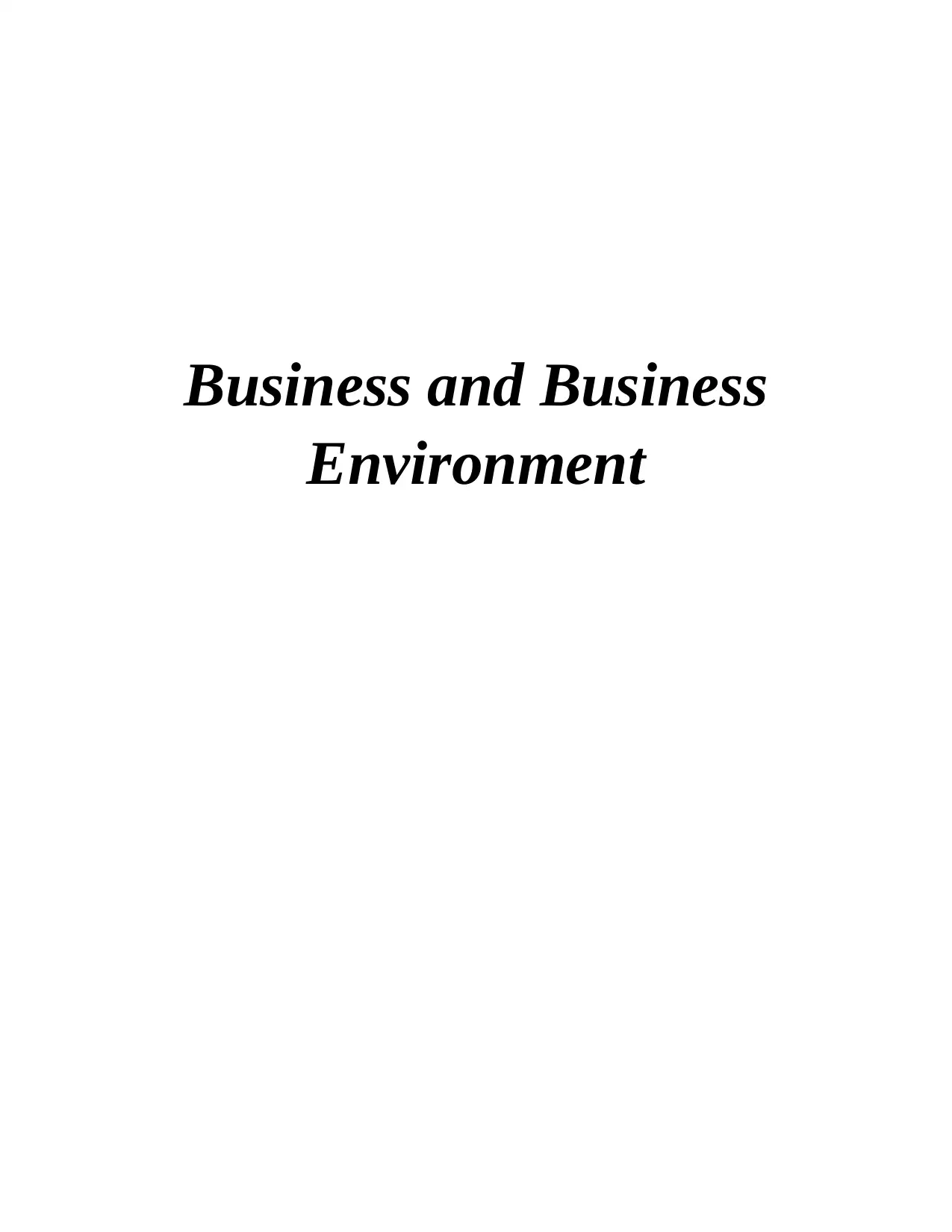
Business and Business
Environment
Environment
Secure Best Marks with AI Grader
Need help grading? Try our AI Grader for instant feedback on your assignments.
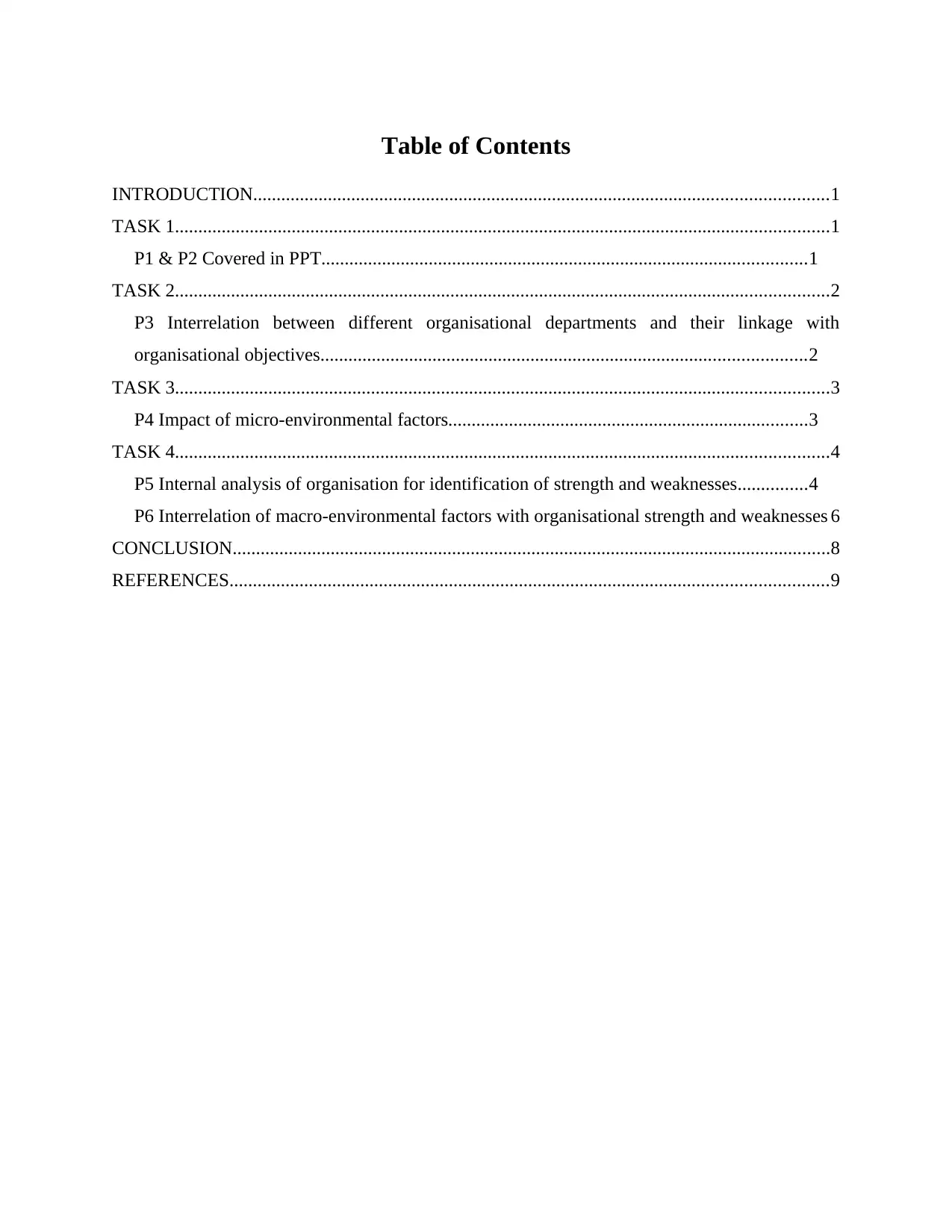
Table of Contents
INTRODUCTION...........................................................................................................................1
TASK 1............................................................................................................................................1
P1 & P2 Covered in PPT........................................................................................................1
TASK 2............................................................................................................................................2
P3 Interrelation between different organisational departments and their linkage with
organisational objectives........................................................................................................2
TASK 3............................................................................................................................................3
P4 Impact of micro-environmental factors.............................................................................3
TASK 4............................................................................................................................................4
P5 Internal analysis of organisation for identification of strength and weaknesses...............4
P6 Interrelation of macro-environmental factors with organisational strength and weaknesses 6
CONCLUSION................................................................................................................................8
REFERENCES................................................................................................................................9
INTRODUCTION...........................................................................................................................1
TASK 1............................................................................................................................................1
P1 & P2 Covered in PPT........................................................................................................1
TASK 2............................................................................................................................................2
P3 Interrelation between different organisational departments and their linkage with
organisational objectives........................................................................................................2
TASK 3............................................................................................................................................3
P4 Impact of micro-environmental factors.............................................................................3
TASK 4............................................................................................................................................4
P5 Internal analysis of organisation for identification of strength and weaknesses...............4
P6 Interrelation of macro-environmental factors with organisational strength and weaknesses 6
CONCLUSION................................................................................................................................8
REFERENCES................................................................................................................................9
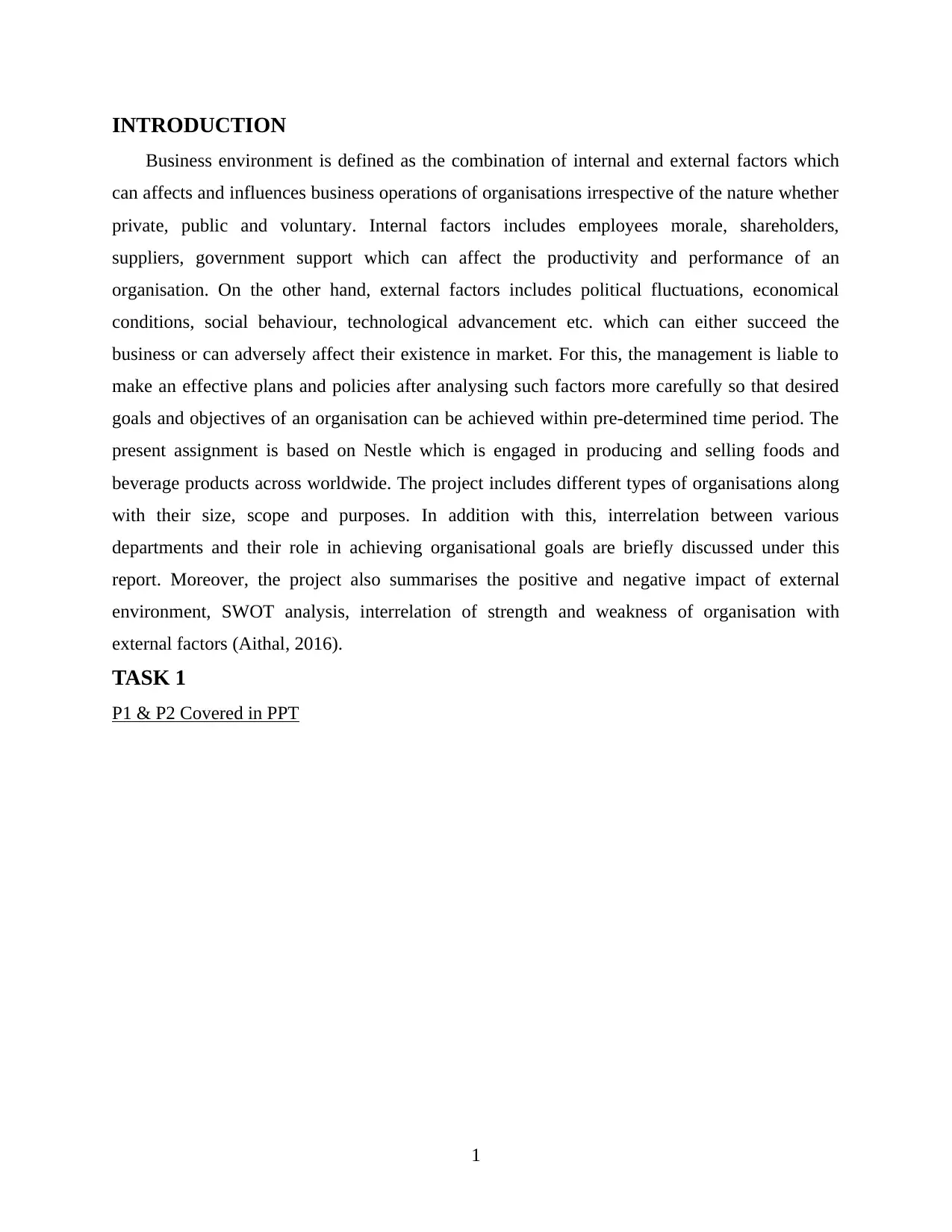
INTRODUCTION
Business environment is defined as the combination of internal and external factors which
can affects and influences business operations of organisations irrespective of the nature whether
private, public and voluntary. Internal factors includes employees morale, shareholders,
suppliers, government support which can affect the productivity and performance of an
organisation. On the other hand, external factors includes political fluctuations, economical
conditions, social behaviour, technological advancement etc. which can either succeed the
business or can adversely affect their existence in market. For this, the management is liable to
make an effective plans and policies after analysing such factors more carefully so that desired
goals and objectives of an organisation can be achieved within pre-determined time period. The
present assignment is based on Nestle which is engaged in producing and selling foods and
beverage products across worldwide. The project includes different types of organisations along
with their size, scope and purposes. In addition with this, interrelation between various
departments and their role in achieving organisational goals are briefly discussed under this
report. Moreover, the project also summarises the positive and negative impact of external
environment, SWOT analysis, interrelation of strength and weakness of organisation with
external factors (Aithal, 2016).
TASK 1
P1 & P2 Covered in PPT
1
Business environment is defined as the combination of internal and external factors which
can affects and influences business operations of organisations irrespective of the nature whether
private, public and voluntary. Internal factors includes employees morale, shareholders,
suppliers, government support which can affect the productivity and performance of an
organisation. On the other hand, external factors includes political fluctuations, economical
conditions, social behaviour, technological advancement etc. which can either succeed the
business or can adversely affect their existence in market. For this, the management is liable to
make an effective plans and policies after analysing such factors more carefully so that desired
goals and objectives of an organisation can be achieved within pre-determined time period. The
present assignment is based on Nestle which is engaged in producing and selling foods and
beverage products across worldwide. The project includes different types of organisations along
with their size, scope and purposes. In addition with this, interrelation between various
departments and their role in achieving organisational goals are briefly discussed under this
report. Moreover, the project also summarises the positive and negative impact of external
environment, SWOT analysis, interrelation of strength and weakness of organisation with
external factors (Aithal, 2016).
TASK 1
P1 & P2 Covered in PPT
1
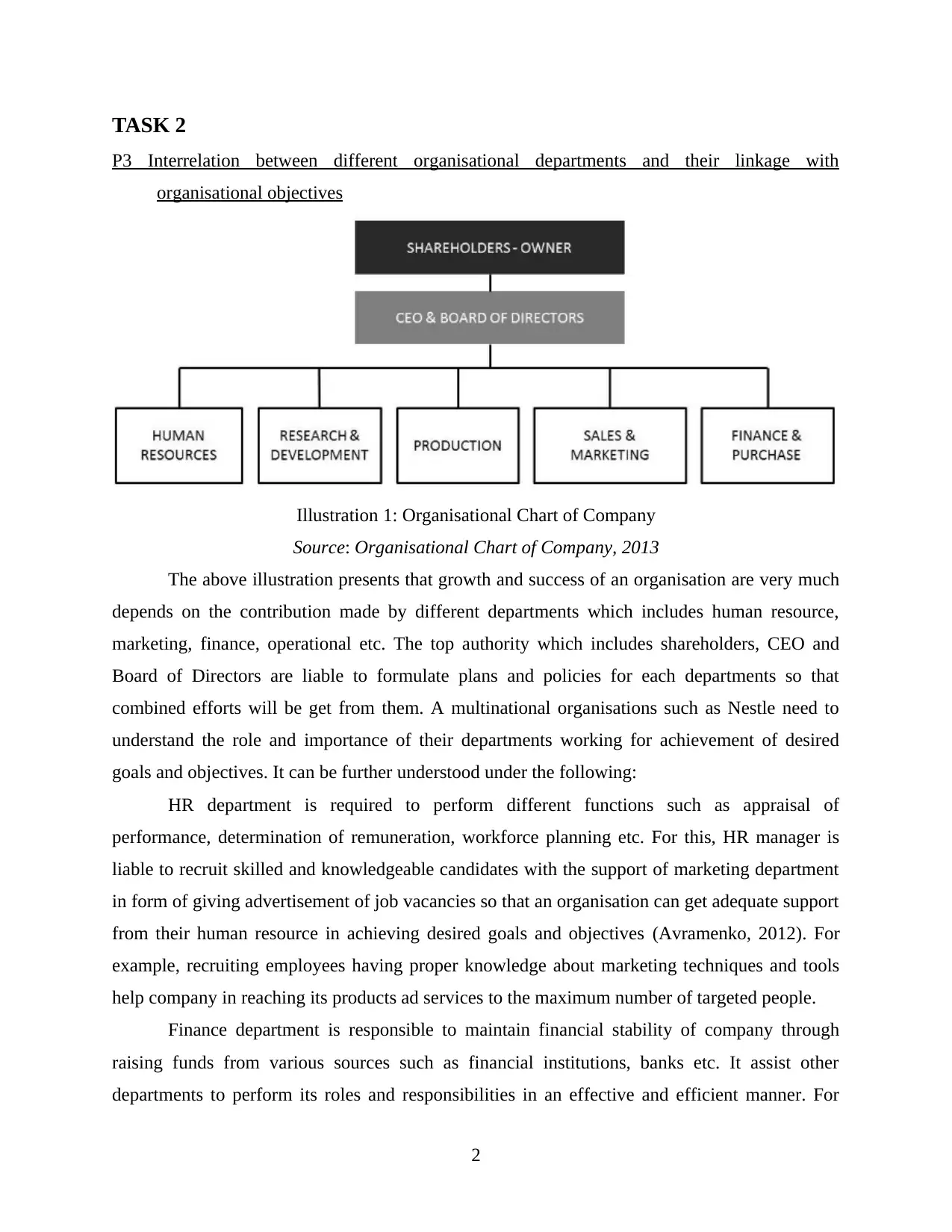
TASK 2
P3 Interrelation between different organisational departments and their linkage with
organisational objectives
Illustration 1: Organisational Chart of Company
Source: Organisational Chart of Company, 2013
The above illustration presents that growth and success of an organisation are very much
depends on the contribution made by different departments which includes human resource,
marketing, finance, operational etc. The top authority which includes shareholders, CEO and
Board of Directors are liable to formulate plans and policies for each departments so that
combined efforts will be get from them. A multinational organisations such as Nestle need to
understand the role and importance of their departments working for achievement of desired
goals and objectives. It can be further understood under the following:
HR department is required to perform different functions such as appraisal of
performance, determination of remuneration, workforce planning etc. For this, HR manager is
liable to recruit skilled and knowledgeable candidates with the support of marketing department
in form of giving advertisement of job vacancies so that an organisation can get adequate support
from their human resource in achieving desired goals and objectives (Avramenko, 2012). For
example, recruiting employees having proper knowledge about marketing techniques and tools
help company in reaching its products ad services to the maximum number of targeted people.
Finance department is responsible to maintain financial stability of company through
raising funds from various sources such as financial institutions, banks etc. It assist other
departments to perform its roles and responsibilities in an effective and efficient manner. For
2
P3 Interrelation between different organisational departments and their linkage with
organisational objectives
Illustration 1: Organisational Chart of Company
Source: Organisational Chart of Company, 2013
The above illustration presents that growth and success of an organisation are very much
depends on the contribution made by different departments which includes human resource,
marketing, finance, operational etc. The top authority which includes shareholders, CEO and
Board of Directors are liable to formulate plans and policies for each departments so that
combined efforts will be get from them. A multinational organisations such as Nestle need to
understand the role and importance of their departments working for achievement of desired
goals and objectives. It can be further understood under the following:
HR department is required to perform different functions such as appraisal of
performance, determination of remuneration, workforce planning etc. For this, HR manager is
liable to recruit skilled and knowledgeable candidates with the support of marketing department
in form of giving advertisement of job vacancies so that an organisation can get adequate support
from their human resource in achieving desired goals and objectives (Avramenko, 2012). For
example, recruiting employees having proper knowledge about marketing techniques and tools
help company in reaching its products ad services to the maximum number of targeted people.
Finance department is responsible to maintain financial stability of company through
raising funds from various sources such as financial institutions, banks etc. It assist other
departments to perform its roles and responsibilities in an effective and efficient manner. For
2
Secure Best Marks with AI Grader
Need help grading? Try our AI Grader for instant feedback on your assignments.
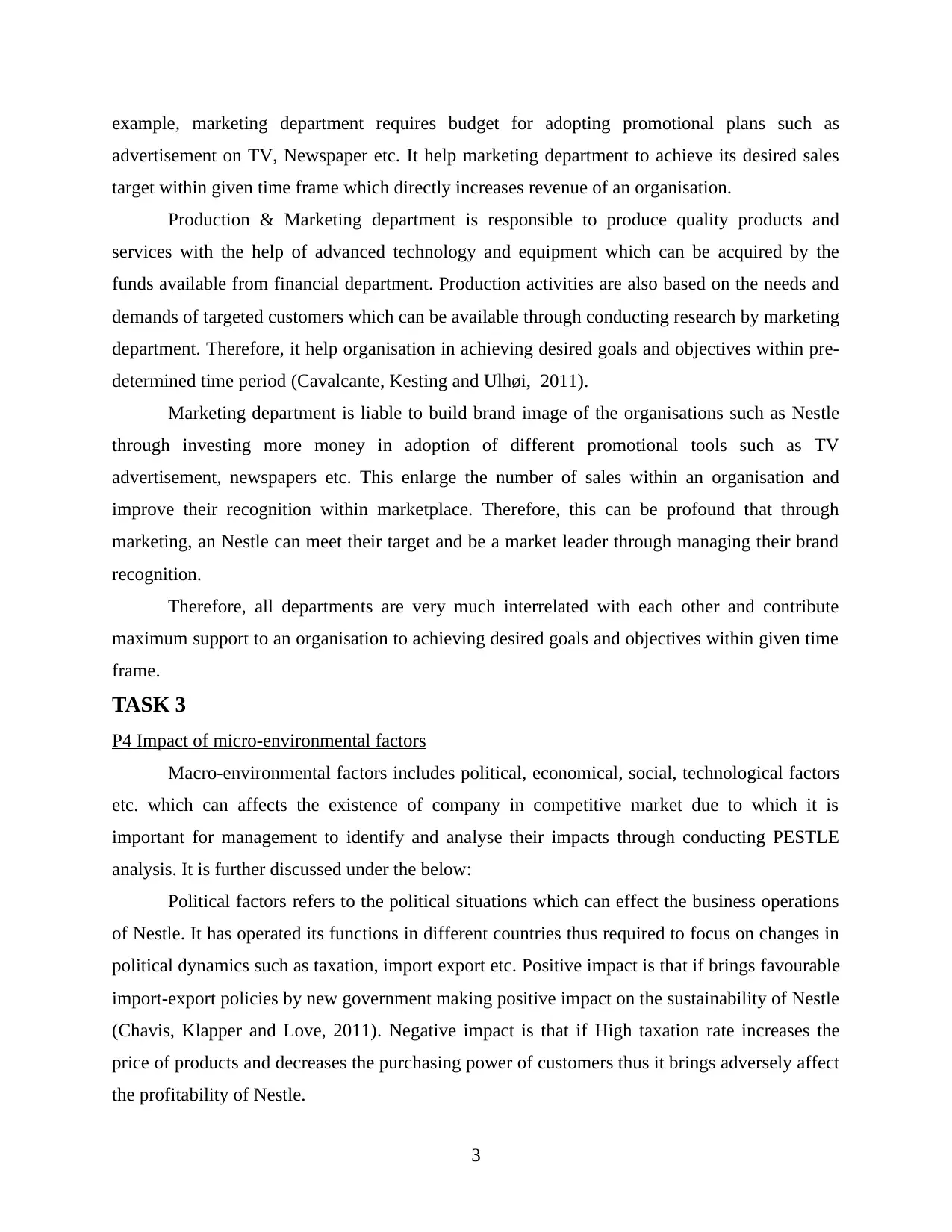
example, marketing department requires budget for adopting promotional plans such as
advertisement on TV, Newspaper etc. It help marketing department to achieve its desired sales
target within given time frame which directly increases revenue of an organisation.
Production & Marketing department is responsible to produce quality products and
services with the help of advanced technology and equipment which can be acquired by the
funds available from financial department. Production activities are also based on the needs and
demands of targeted customers which can be available through conducting research by marketing
department. Therefore, it help organisation in achieving desired goals and objectives within pre-
determined time period (Cavalcante, Kesting and Ulhøi, 2011).
Marketing department is liable to build brand image of the organisations such as Nestle
through investing more money in adoption of different promotional tools such as TV
advertisement, newspapers etc. This enlarge the number of sales within an organisation and
improve their recognition within marketplace. Therefore, this can be profound that through
marketing, an Nestle can meet their target and be a market leader through managing their brand
recognition.
Therefore, all departments are very much interrelated with each other and contribute
maximum support to an organisation to achieving desired goals and objectives within given time
frame.
TASK 3
P4 Impact of micro-environmental factors
Macro-environmental factors includes political, economical, social, technological factors
etc. which can affects the existence of company in competitive market due to which it is
important for management to identify and analyse their impacts through conducting PESTLE
analysis. It is further discussed under the below:
Political factors refers to the political situations which can effect the business operations
of Nestle. It has operated its functions in different countries thus required to focus on changes in
political dynamics such as taxation, import export etc. Positive impact is that if brings favourable
import-export policies by new government making positive impact on the sustainability of Nestle
(Chavis, Klapper and Love, 2011). Negative impact is that if High taxation rate increases the
price of products and decreases the purchasing power of customers thus it brings adversely affect
the profitability of Nestle.
3
advertisement on TV, Newspaper etc. It help marketing department to achieve its desired sales
target within given time frame which directly increases revenue of an organisation.
Production & Marketing department is responsible to produce quality products and
services with the help of advanced technology and equipment which can be acquired by the
funds available from financial department. Production activities are also based on the needs and
demands of targeted customers which can be available through conducting research by marketing
department. Therefore, it help organisation in achieving desired goals and objectives within pre-
determined time period (Cavalcante, Kesting and Ulhøi, 2011).
Marketing department is liable to build brand image of the organisations such as Nestle
through investing more money in adoption of different promotional tools such as TV
advertisement, newspapers etc. This enlarge the number of sales within an organisation and
improve their recognition within marketplace. Therefore, this can be profound that through
marketing, an Nestle can meet their target and be a market leader through managing their brand
recognition.
Therefore, all departments are very much interrelated with each other and contribute
maximum support to an organisation to achieving desired goals and objectives within given time
frame.
TASK 3
P4 Impact of micro-environmental factors
Macro-environmental factors includes political, economical, social, technological factors
etc. which can affects the existence of company in competitive market due to which it is
important for management to identify and analyse their impacts through conducting PESTLE
analysis. It is further discussed under the below:
Political factors refers to the political situations which can effect the business operations
of Nestle. It has operated its functions in different countries thus required to focus on changes in
political dynamics such as taxation, import export etc. Positive impact is that if brings favourable
import-export policies by new government making positive impact on the sustainability of Nestle
(Chavis, Klapper and Love, 2011). Negative impact is that if High taxation rate increases the
price of products and decreases the purchasing power of customers thus it brings adversely affect
the profitability of Nestle.
3
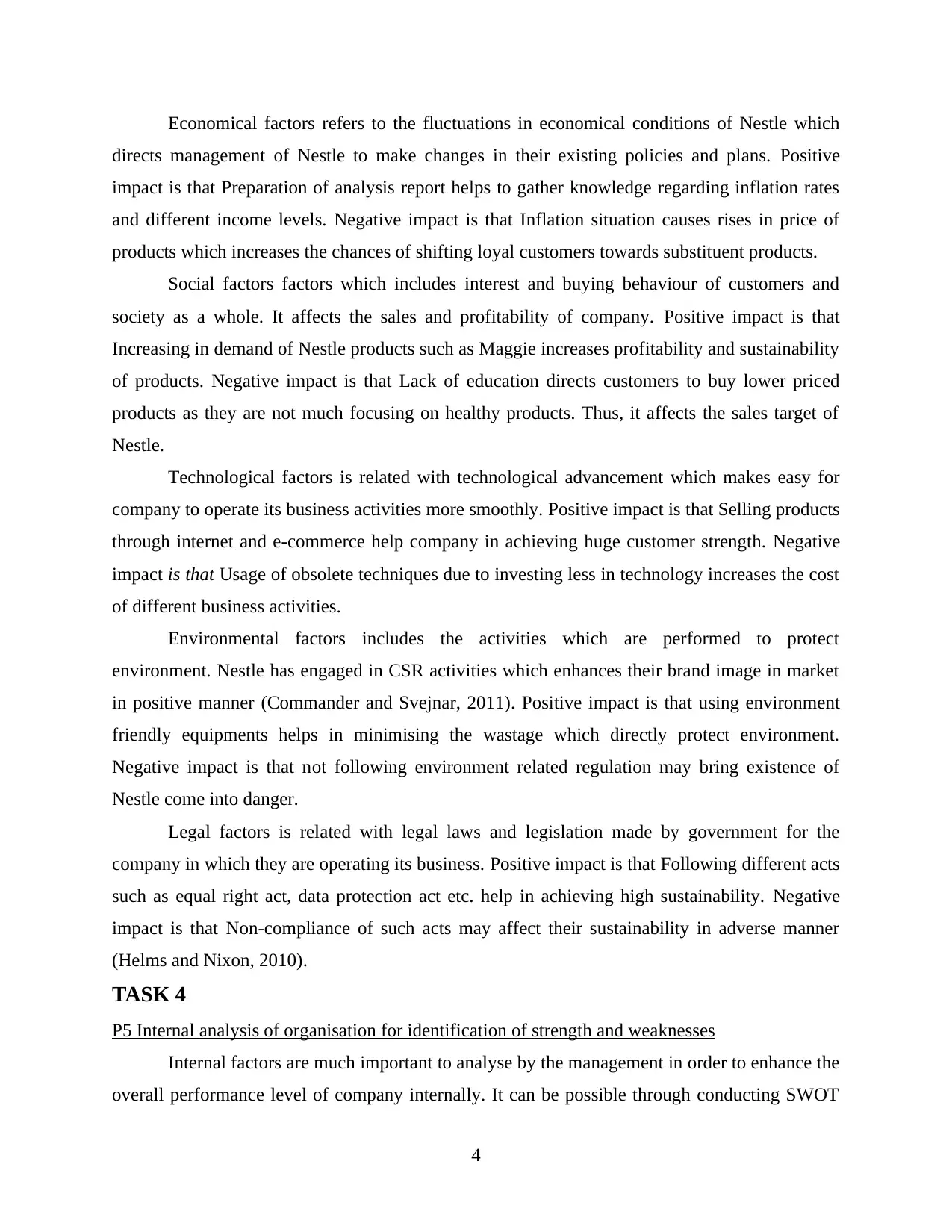
Economical factors refers to the fluctuations in economical conditions of Nestle which
directs management of Nestle to make changes in their existing policies and plans. Positive
impact is that Preparation of analysis report helps to gather knowledge regarding inflation rates
and different income levels. Negative impact is that Inflation situation causes rises in price of
products which increases the chances of shifting loyal customers towards substituent products.
Social factors factors which includes interest and buying behaviour of customers and
society as a whole. It affects the sales and profitability of company. Positive impact is that
Increasing in demand of Nestle products such as Maggie increases profitability and sustainability
of products. Negative impact is that Lack of education directs customers to buy lower priced
products as they are not much focusing on healthy products. Thus, it affects the sales target of
Nestle.
Technological factors is related with technological advancement which makes easy for
company to operate its business activities more smoothly. Positive impact is that Selling products
through internet and e-commerce help company in achieving huge customer strength. Negative
impact is that Usage of obsolete techniques due to investing less in technology increases the cost
of different business activities.
Environmental factors includes the activities which are performed to protect
environment. Nestle has engaged in CSR activities which enhances their brand image in market
in positive manner (Commander and Svejnar, 2011). Positive impact is that using environment
friendly equipments helps in minimising the wastage which directly protect environment.
Negative impact is that not following environment related regulation may bring existence of
Nestle come into danger.
Legal factors is related with legal laws and legislation made by government for the
company in which they are operating its business. Positive impact is that Following different acts
such as equal right act, data protection act etc. help in achieving high sustainability. Negative
impact is that Non-compliance of such acts may affect their sustainability in adverse manner
(Helms and Nixon, 2010).
TASK 4
P5 Internal analysis of organisation for identification of strength and weaknesses
Internal factors are much important to analyse by the management in order to enhance the
overall performance level of company internally. It can be possible through conducting SWOT
4
directs management of Nestle to make changes in their existing policies and plans. Positive
impact is that Preparation of analysis report helps to gather knowledge regarding inflation rates
and different income levels. Negative impact is that Inflation situation causes rises in price of
products which increases the chances of shifting loyal customers towards substituent products.
Social factors factors which includes interest and buying behaviour of customers and
society as a whole. It affects the sales and profitability of company. Positive impact is that
Increasing in demand of Nestle products such as Maggie increases profitability and sustainability
of products. Negative impact is that Lack of education directs customers to buy lower priced
products as they are not much focusing on healthy products. Thus, it affects the sales target of
Nestle.
Technological factors is related with technological advancement which makes easy for
company to operate its business activities more smoothly. Positive impact is that Selling products
through internet and e-commerce help company in achieving huge customer strength. Negative
impact is that Usage of obsolete techniques due to investing less in technology increases the cost
of different business activities.
Environmental factors includes the activities which are performed to protect
environment. Nestle has engaged in CSR activities which enhances their brand image in market
in positive manner (Commander and Svejnar, 2011). Positive impact is that using environment
friendly equipments helps in minimising the wastage which directly protect environment.
Negative impact is that not following environment related regulation may bring existence of
Nestle come into danger.
Legal factors is related with legal laws and legislation made by government for the
company in which they are operating its business. Positive impact is that Following different acts
such as equal right act, data protection act etc. help in achieving high sustainability. Negative
impact is that Non-compliance of such acts may affect their sustainability in adverse manner
(Helms and Nixon, 2010).
TASK 4
P5 Internal analysis of organisation for identification of strength and weaknesses
Internal factors are much important to analyse by the management in order to enhance the
overall performance level of company internally. It can be possible through conducting SWOT
4
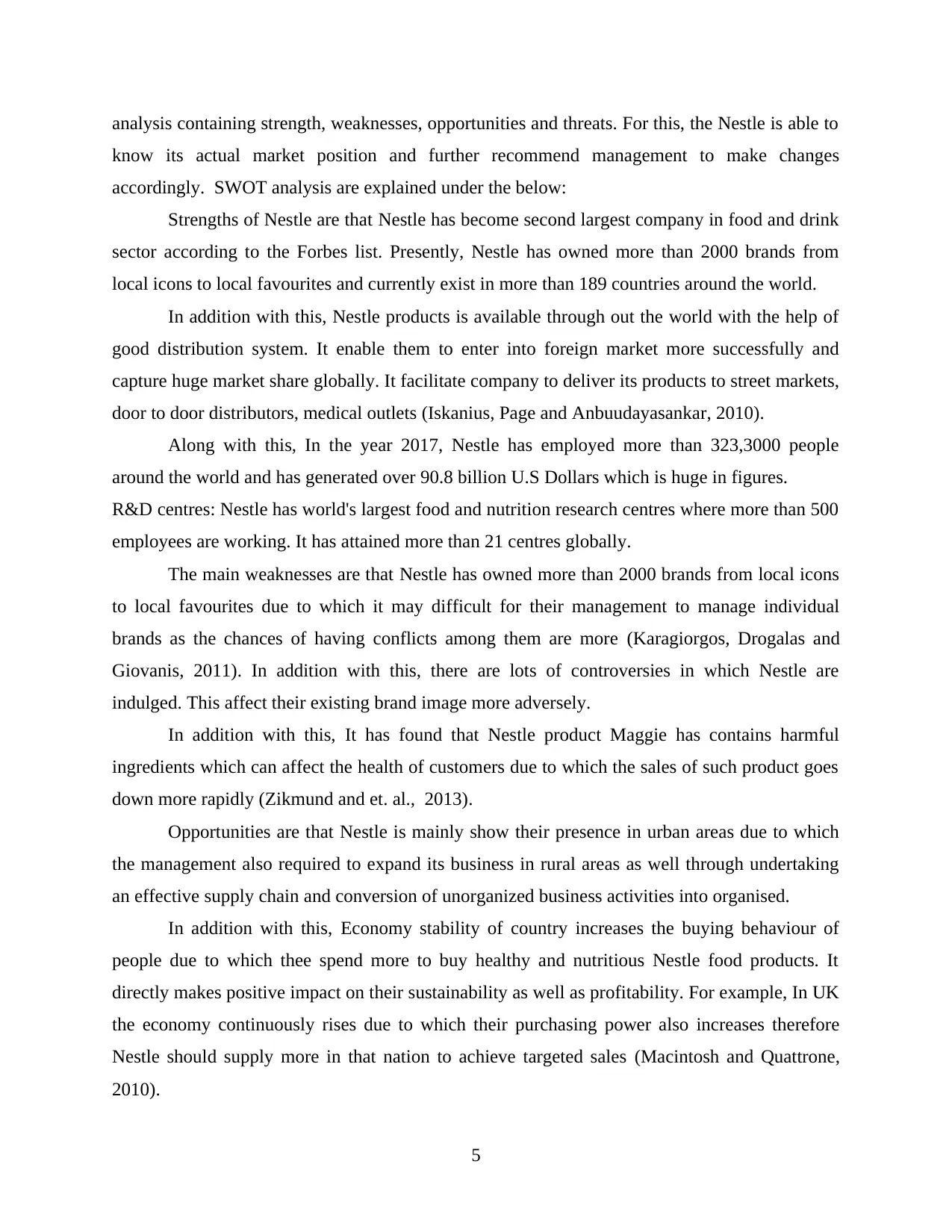
analysis containing strength, weaknesses, opportunities and threats. For this, the Nestle is able to
know its actual market position and further recommend management to make changes
accordingly. SWOT analysis are explained under the below:
Strengths of Nestle are that Nestle has become second largest company in food and drink
sector according to the Forbes list. Presently, Nestle has owned more than 2000 brands from
local icons to local favourites and currently exist in more than 189 countries around the world.
In addition with this, Nestle products is available through out the world with the help of
good distribution system. It enable them to enter into foreign market more successfully and
capture huge market share globally. It facilitate company to deliver its products to street markets,
door to door distributors, medical outlets (Iskanius, Page and Anbuudayasankar, 2010).
Along with this, In the year 2017, Nestle has employed more than 323,3000 people
around the world and has generated over 90.8 billion U.S Dollars which is huge in figures.
R&D centres: Nestle has world's largest food and nutrition research centres where more than 500
employees are working. It has attained more than 21 centres globally.
The main weaknesses are that Nestle has owned more than 2000 brands from local icons
to local favourites due to which it may difficult for their management to manage individual
brands as the chances of having conflicts among them are more (Karagiorgos, Drogalas and
Giovanis, 2011). In addition with this, there are lots of controversies in which Nestle are
indulged. This affect their existing brand image more adversely.
In addition with this, It has found that Nestle product Maggie has contains harmful
ingredients which can affect the health of customers due to which the sales of such product goes
down more rapidly (Zikmund and et. al., 2013).
Opportunities are that Nestle is mainly show their presence in urban areas due to which
the management also required to expand its business in rural areas as well through undertaking
an effective supply chain and conversion of unorganized business activities into organised.
In addition with this, Economy stability of country increases the buying behaviour of
people due to which thee spend more to buy healthy and nutritious Nestle food products. It
directly makes positive impact on their sustainability as well as profitability. For example, In UK
the economy continuously rises due to which their purchasing power also increases therefore
Nestle should supply more in that nation to achieve targeted sales (Macintosh and Quattrone,
2010).
5
know its actual market position and further recommend management to make changes
accordingly. SWOT analysis are explained under the below:
Strengths of Nestle are that Nestle has become second largest company in food and drink
sector according to the Forbes list. Presently, Nestle has owned more than 2000 brands from
local icons to local favourites and currently exist in more than 189 countries around the world.
In addition with this, Nestle products is available through out the world with the help of
good distribution system. It enable them to enter into foreign market more successfully and
capture huge market share globally. It facilitate company to deliver its products to street markets,
door to door distributors, medical outlets (Iskanius, Page and Anbuudayasankar, 2010).
Along with this, In the year 2017, Nestle has employed more than 323,3000 people
around the world and has generated over 90.8 billion U.S Dollars which is huge in figures.
R&D centres: Nestle has world's largest food and nutrition research centres where more than 500
employees are working. It has attained more than 21 centres globally.
The main weaknesses are that Nestle has owned more than 2000 brands from local icons
to local favourites due to which it may difficult for their management to manage individual
brands as the chances of having conflicts among them are more (Karagiorgos, Drogalas and
Giovanis, 2011). In addition with this, there are lots of controversies in which Nestle are
indulged. This affect their existing brand image more adversely.
In addition with this, It has found that Nestle product Maggie has contains harmful
ingredients which can affect the health of customers due to which the sales of such product goes
down more rapidly (Zikmund and et. al., 2013).
Opportunities are that Nestle is mainly show their presence in urban areas due to which
the management also required to expand its business in rural areas as well through undertaking
an effective supply chain and conversion of unorganized business activities into organised.
In addition with this, Economy stability of country increases the buying behaviour of
people due to which thee spend more to buy healthy and nutritious Nestle food products. It
directly makes positive impact on their sustainability as well as profitability. For example, In UK
the economy continuously rises due to which their purchasing power also increases therefore
Nestle should supply more in that nation to achieve targeted sales (Macintosh and Quattrone,
2010).
5
Paraphrase This Document
Need a fresh take? Get an instant paraphrase of this document with our AI Paraphraser
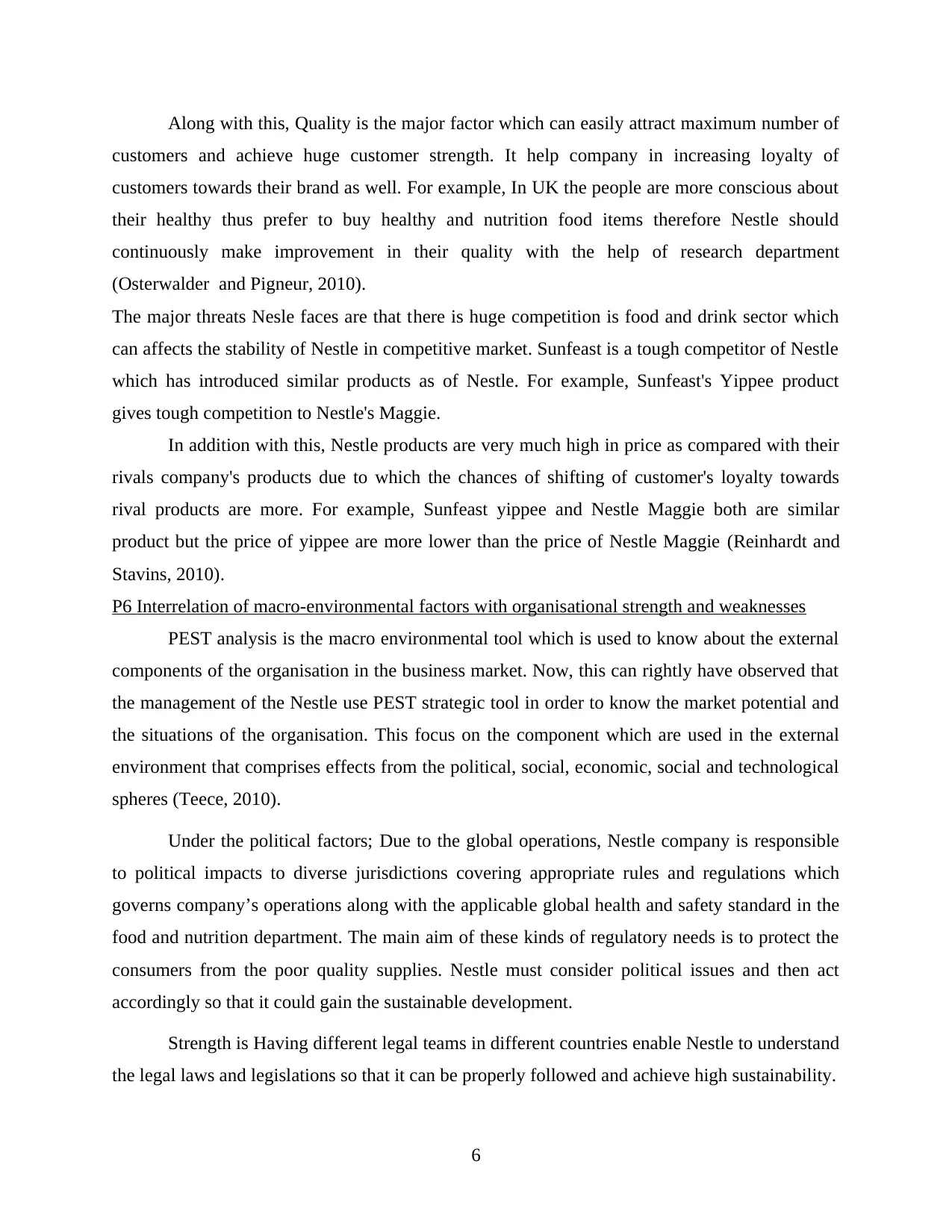
Along with this, Quality is the major factor which can easily attract maximum number of
customers and achieve huge customer strength. It help company in increasing loyalty of
customers towards their brand as well. For example, In UK the people are more conscious about
their healthy thus prefer to buy healthy and nutrition food items therefore Nestle should
continuously make improvement in their quality with the help of research department
(Osterwalder and Pigneur, 2010).
The major threats Nesle faces are that there is huge competition is food and drink sector which
can affects the stability of Nestle in competitive market. Sunfeast is a tough competitor of Nestle
which has introduced similar products as of Nestle. For example, Sunfeast's Yippee product
gives tough competition to Nestle's Maggie.
In addition with this, Nestle products are very much high in price as compared with their
rivals company's products due to which the chances of shifting of customer's loyalty towards
rival products are more. For example, Sunfeast yippee and Nestle Maggie both are similar
product but the price of yippee are more lower than the price of Nestle Maggie (Reinhardt and
Stavins, 2010).
P6 Interrelation of macro-environmental factors with organisational strength and weaknesses
PEST analysis is the macro environmental tool which is used to know about the external
components of the organisation in the business market. Now, this can rightly have observed that
the management of the Nestle use PEST strategic tool in order to know the market potential and
the situations of the organisation. This focus on the component which are used in the external
environment that comprises effects from the political, social, economic, social and technological
spheres (Teece, 2010).
Under the political factors; Due to the global operations, Nestle company is responsible
to political impacts to diverse jurisdictions covering appropriate rules and regulations which
governs company’s operations along with the applicable global health and safety standard in the
food and nutrition department. The main aim of these kinds of regulatory needs is to protect the
consumers from the poor quality supplies. Nestle must consider political issues and then act
accordingly so that it could gain the sustainable development.
Strength is Having different legal teams in different countries enable Nestle to understand
the legal laws and legislations so that it can be properly followed and achieve high sustainability.
6
customers and achieve huge customer strength. It help company in increasing loyalty of
customers towards their brand as well. For example, In UK the people are more conscious about
their healthy thus prefer to buy healthy and nutrition food items therefore Nestle should
continuously make improvement in their quality with the help of research department
(Osterwalder and Pigneur, 2010).
The major threats Nesle faces are that there is huge competition is food and drink sector which
can affects the stability of Nestle in competitive market. Sunfeast is a tough competitor of Nestle
which has introduced similar products as of Nestle. For example, Sunfeast's Yippee product
gives tough competition to Nestle's Maggie.
In addition with this, Nestle products are very much high in price as compared with their
rivals company's products due to which the chances of shifting of customer's loyalty towards
rival products are more. For example, Sunfeast yippee and Nestle Maggie both are similar
product but the price of yippee are more lower than the price of Nestle Maggie (Reinhardt and
Stavins, 2010).
P6 Interrelation of macro-environmental factors with organisational strength and weaknesses
PEST analysis is the macro environmental tool which is used to know about the external
components of the organisation in the business market. Now, this can rightly have observed that
the management of the Nestle use PEST strategic tool in order to know the market potential and
the situations of the organisation. This focus on the component which are used in the external
environment that comprises effects from the political, social, economic, social and technological
spheres (Teece, 2010).
Under the political factors; Due to the global operations, Nestle company is responsible
to political impacts to diverse jurisdictions covering appropriate rules and regulations which
governs company’s operations along with the applicable global health and safety standard in the
food and nutrition department. The main aim of these kinds of regulatory needs is to protect the
consumers from the poor quality supplies. Nestle must consider political issues and then act
accordingly so that it could gain the sustainable development.
Strength is Having different legal teams in different countries enable Nestle to understand
the legal laws and legislations so that it can be properly followed and achieve high sustainability.
6
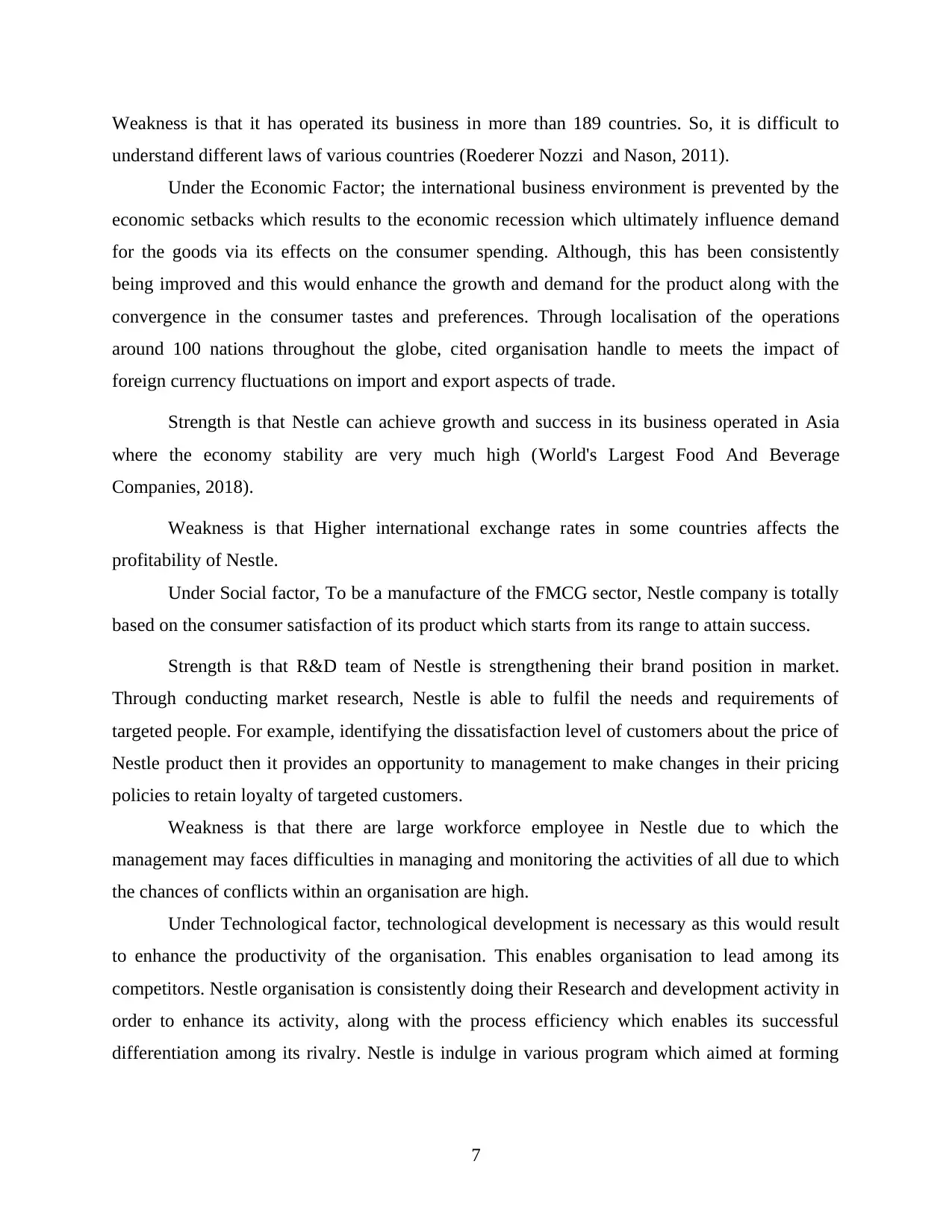
Weakness is that it has operated its business in more than 189 countries. So, it is difficult to
understand different laws of various countries (Roederer Nozzi and Nason, 2011).
Under the Economic Factor; the international business environment is prevented by the
economic setbacks which results to the economic recession which ultimately influence demand
for the goods via its effects on the consumer spending. Although, this has been consistently
being improved and this would enhance the growth and demand for the product along with the
convergence in the consumer tastes and preferences. Through localisation of the operations
around 100 nations throughout the globe, cited organisation handle to meets the impact of
foreign currency fluctuations on import and export aspects of trade.
Strength is that Nestle can achieve growth and success in its business operated in Asia
where the economy stability are very much high (World's Largest Food And Beverage
Companies, 2018).
Weakness is that Higher international exchange rates in some countries affects the
profitability of Nestle.
Under Social factor, To be a manufacture of the FMCG sector, Nestle company is totally
based on the consumer satisfaction of its product which starts from its range to attain success.
Strength is that R&D team of Nestle is strengthening their brand position in market.
Through conducting market research, Nestle is able to fulfil the needs and requirements of
targeted people. For example, identifying the dissatisfaction level of customers about the price of
Nestle product then it provides an opportunity to management to make changes in their pricing
policies to retain loyalty of targeted customers.
Weakness is that there are large workforce employee in Nestle due to which the
management may faces difficulties in managing and monitoring the activities of all due to which
the chances of conflicts within an organisation are high.
Under Technological factor, technological development is necessary as this would result
to enhance the productivity of the organisation. This enables organisation to lead among its
competitors. Nestle organisation is consistently doing their Research and development activity in
order to enhance its activity, along with the process efficiency which enables its successful
differentiation among its rivalry. Nestle is indulge in various program which aimed at forming
7
understand different laws of various countries (Roederer Nozzi and Nason, 2011).
Under the Economic Factor; the international business environment is prevented by the
economic setbacks which results to the economic recession which ultimately influence demand
for the goods via its effects on the consumer spending. Although, this has been consistently
being improved and this would enhance the growth and demand for the product along with the
convergence in the consumer tastes and preferences. Through localisation of the operations
around 100 nations throughout the globe, cited organisation handle to meets the impact of
foreign currency fluctuations on import and export aspects of trade.
Strength is that Nestle can achieve growth and success in its business operated in Asia
where the economy stability are very much high (World's Largest Food And Beverage
Companies, 2018).
Weakness is that Higher international exchange rates in some countries affects the
profitability of Nestle.
Under Social factor, To be a manufacture of the FMCG sector, Nestle company is totally
based on the consumer satisfaction of its product which starts from its range to attain success.
Strength is that R&D team of Nestle is strengthening their brand position in market.
Through conducting market research, Nestle is able to fulfil the needs and requirements of
targeted people. For example, identifying the dissatisfaction level of customers about the price of
Nestle product then it provides an opportunity to management to make changes in their pricing
policies to retain loyalty of targeted customers.
Weakness is that there are large workforce employee in Nestle due to which the
management may faces difficulties in managing and monitoring the activities of all due to which
the chances of conflicts within an organisation are high.
Under Technological factor, technological development is necessary as this would result
to enhance the productivity of the organisation. This enables organisation to lead among its
competitors. Nestle organisation is consistently doing their Research and development activity in
order to enhance its activity, along with the process efficiency which enables its successful
differentiation among its rivalry. Nestle is indulge in various program which aimed at forming
7
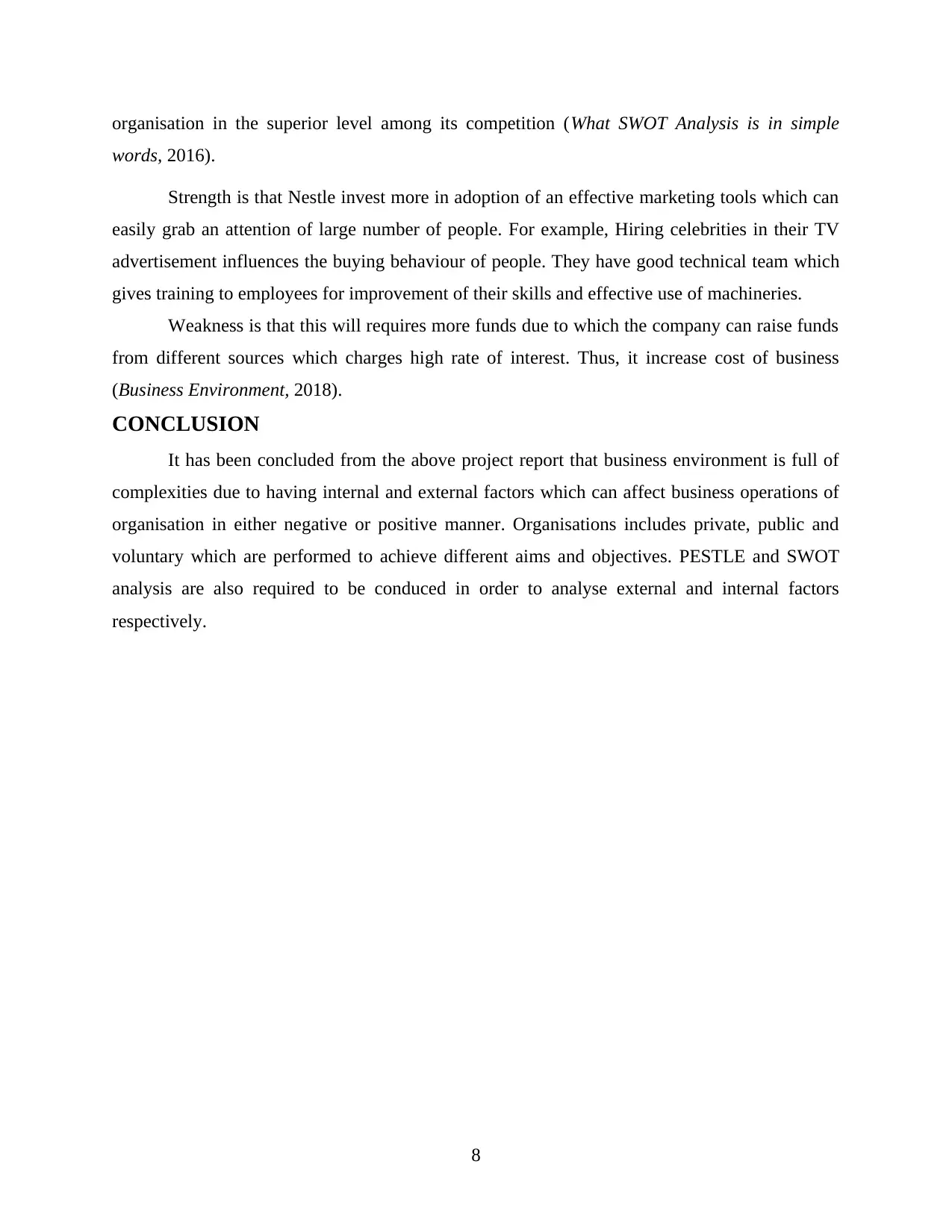
organisation in the superior level among its competition (What SWOT Analysis is in simple
words, 2016).
Strength is that Nestle invest more in adoption of an effective marketing tools which can
easily grab an attention of large number of people. For example, Hiring celebrities in their TV
advertisement influences the buying behaviour of people. They have good technical team which
gives training to employees for improvement of their skills and effective use of machineries.
Weakness is that this will requires more funds due to which the company can raise funds
from different sources which charges high rate of interest. Thus, it increase cost of business
(Business Environment, 2018).
CONCLUSION
It has been concluded from the above project report that business environment is full of
complexities due to having internal and external factors which can affect business operations of
organisation in either negative or positive manner. Organisations includes private, public and
voluntary which are performed to achieve different aims and objectives. PESTLE and SWOT
analysis are also required to be conduced in order to analyse external and internal factors
respectively.
8
words, 2016).
Strength is that Nestle invest more in adoption of an effective marketing tools which can
easily grab an attention of large number of people. For example, Hiring celebrities in their TV
advertisement influences the buying behaviour of people. They have good technical team which
gives training to employees for improvement of their skills and effective use of machineries.
Weakness is that this will requires more funds due to which the company can raise funds
from different sources which charges high rate of interest. Thus, it increase cost of business
(Business Environment, 2018).
CONCLUSION
It has been concluded from the above project report that business environment is full of
complexities due to having internal and external factors which can affect business operations of
organisation in either negative or positive manner. Organisations includes private, public and
voluntary which are performed to achieve different aims and objectives. PESTLE and SWOT
analysis are also required to be conduced in order to analyse external and internal factors
respectively.
8
Secure Best Marks with AI Grader
Need help grading? Try our AI Grader for instant feedback on your assignments.
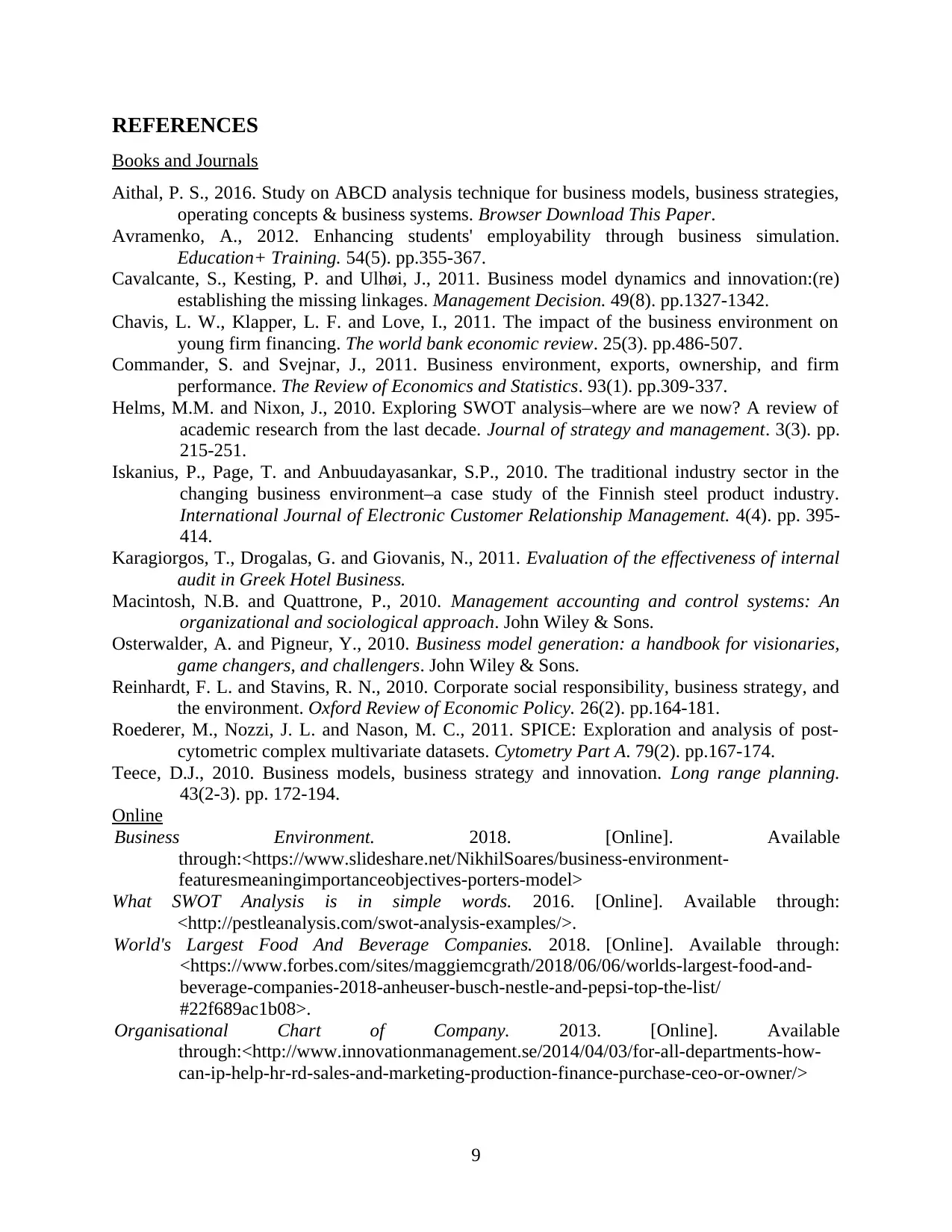
REFERENCES
Books and Journals
Aithal, P. S., 2016. Study on ABCD analysis technique for business models, business strategies,
operating concepts & business systems. Browser Download This Paper.
Avramenko, A., 2012. Enhancing students' employability through business simulation.
Education+ Training. 54(5). pp.355-367.
Cavalcante, S., Kesting, P. and Ulhøi, J., 2011. Business model dynamics and innovation:(re)
establishing the missing linkages. Management Decision. 49(8). pp.1327-1342.
Chavis, L. W., Klapper, L. F. and Love, I., 2011. The impact of the business environment on
young firm financing. The world bank economic review. 25(3). pp.486-507.
Commander, S. and Svejnar, J., 2011. Business environment, exports, ownership, and firm
performance. The Review of Economics and Statistics. 93(1). pp.309-337.
Helms, M.M. and Nixon, J., 2010. Exploring SWOT analysis–where are we now? A review of
academic research from the last decade. Journal of strategy and management. 3(3). pp.
215-251.
Iskanius, P., Page, T. and Anbuudayasankar, S.P., 2010. The traditional industry sector in the
changing business environment–a case study of the Finnish steel product industry.
International Journal of Electronic Customer Relationship Management. 4(4). pp. 395-
414.
Karagiorgos, T., Drogalas, G. and Giovanis, N., 2011. Evaluation of the effectiveness of internal
audit in Greek Hotel Business.
Macintosh, N.B. and Quattrone, P., 2010. Management accounting and control systems: An
organizational and sociological approach. John Wiley & Sons.
Osterwalder, A. and Pigneur, Y., 2010. Business model generation: a handbook for visionaries,
game changers, and challengers. John Wiley & Sons.
Reinhardt, F. L. and Stavins, R. N., 2010. Corporate social responsibility, business strategy, and
the environment. Oxford Review of Economic Policy. 26(2). pp.164-181.
Roederer, M., Nozzi, J. L. and Nason, M. C., 2011. SPICE: Exploration and analysis of post‐
cytometric complex multivariate datasets. Cytometry Part A. 79(2). pp.167-174.
Teece, D.J., 2010. Business models, business strategy and innovation. Long range planning.
43(2-3). pp. 172-194.
Online
Business Environment. 2018. [Online]. Available
through:<https://www.slideshare.net/NikhilSoares/business-environment-
featuresmeaningimportanceobjectives-porters-model>
What SWOT Analysis is in simple words. 2016. [Online]. Available through:
<http://pestleanalysis.com/swot-analysis-examples/>.
World's Largest Food And Beverage Companies. 2018. [Online]. Available through:
<https://www.forbes.com/sites/maggiemcgrath/2018/06/06/worlds-largest-food-and-
beverage-companies-2018-anheuser-busch-nestle-and-pepsi-top-the-list/
#22f689ac1b08>.
Organisational Chart of Company. 2013. [Online]. Available
through:<http://www.innovationmanagement.se/2014/04/03/for-all-departments-how-
can-ip-help-hr-rd-sales-and-marketing-production-finance-purchase-ceo-or-owner/>
9
Books and Journals
Aithal, P. S., 2016. Study on ABCD analysis technique for business models, business strategies,
operating concepts & business systems. Browser Download This Paper.
Avramenko, A., 2012. Enhancing students' employability through business simulation.
Education+ Training. 54(5). pp.355-367.
Cavalcante, S., Kesting, P. and Ulhøi, J., 2011. Business model dynamics and innovation:(re)
establishing the missing linkages. Management Decision. 49(8). pp.1327-1342.
Chavis, L. W., Klapper, L. F. and Love, I., 2011. The impact of the business environment on
young firm financing. The world bank economic review. 25(3). pp.486-507.
Commander, S. and Svejnar, J., 2011. Business environment, exports, ownership, and firm
performance. The Review of Economics and Statistics. 93(1). pp.309-337.
Helms, M.M. and Nixon, J., 2010. Exploring SWOT analysis–where are we now? A review of
academic research from the last decade. Journal of strategy and management. 3(3). pp.
215-251.
Iskanius, P., Page, T. and Anbuudayasankar, S.P., 2010. The traditional industry sector in the
changing business environment–a case study of the Finnish steel product industry.
International Journal of Electronic Customer Relationship Management. 4(4). pp. 395-
414.
Karagiorgos, T., Drogalas, G. and Giovanis, N., 2011. Evaluation of the effectiveness of internal
audit in Greek Hotel Business.
Macintosh, N.B. and Quattrone, P., 2010. Management accounting and control systems: An
organizational and sociological approach. John Wiley & Sons.
Osterwalder, A. and Pigneur, Y., 2010. Business model generation: a handbook for visionaries,
game changers, and challengers. John Wiley & Sons.
Reinhardt, F. L. and Stavins, R. N., 2010. Corporate social responsibility, business strategy, and
the environment. Oxford Review of Economic Policy. 26(2). pp.164-181.
Roederer, M., Nozzi, J. L. and Nason, M. C., 2011. SPICE: Exploration and analysis of post‐
cytometric complex multivariate datasets. Cytometry Part A. 79(2). pp.167-174.
Teece, D.J., 2010. Business models, business strategy and innovation. Long range planning.
43(2-3). pp. 172-194.
Online
Business Environment. 2018. [Online]. Available
through:<https://www.slideshare.net/NikhilSoares/business-environment-
featuresmeaningimportanceobjectives-porters-model>
What SWOT Analysis is in simple words. 2016. [Online]. Available through:
<http://pestleanalysis.com/swot-analysis-examples/>.
World's Largest Food And Beverage Companies. 2018. [Online]. Available through:
<https://www.forbes.com/sites/maggiemcgrath/2018/06/06/worlds-largest-food-and-
beverage-companies-2018-anheuser-busch-nestle-and-pepsi-top-the-list/
#22f689ac1b08>.
Organisational Chart of Company. 2013. [Online]. Available
through:<http://www.innovationmanagement.se/2014/04/03/for-all-departments-how-
can-ip-help-hr-rd-sales-and-marketing-production-finance-purchase-ceo-or-owner/>
9
1 out of 11
Related Documents
Your All-in-One AI-Powered Toolkit for Academic Success.
+13062052269
info@desklib.com
Available 24*7 on WhatsApp / Email
![[object Object]](/_next/static/media/star-bottom.7253800d.svg)
Unlock your academic potential
© 2024 | Zucol Services PVT LTD | All rights reserved.





